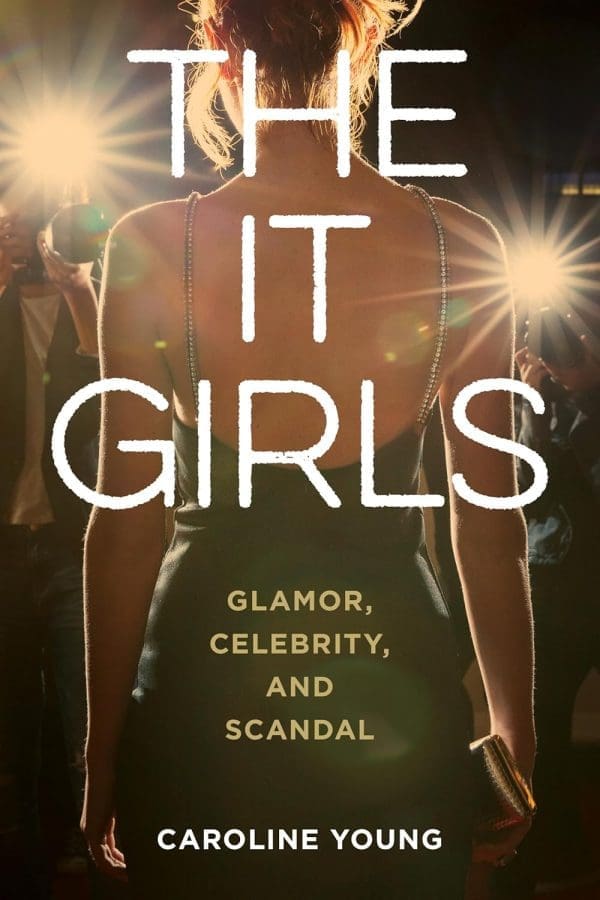
What’s the story behind how the term ‘It girl’ came to be?
The original ‘It’ girl was Clara Bow, the silent movie star who was branded with the moniker as part of a publicity campaign by her studio to promote her 1927 movie It. Writer Elinor Glyn, had coined the expression to describe a magnetic quality that makes all men want to be with her, and other women want to be her. Of course, there had been ‘It’ girls before, but they had been courtesans, celebrities, mistresses and ‘stunners’, which was how the pre-Raphaelites described their models.
Why are we so fascinated by young, beautiful women, and why do we love to tear them down?
From the early days of mass media, women have been used as a commodity to sell products. While they are worshiped for their looks, society expects women to be gentle and subservient, and when they step outside of that behavior, they are punished for it. There’s a pleasure in tearing down ‘It’ girls in the same way that women make the best victims in horror movies. It’s about keeping her in her place – she can be a beautiful object, but if she resists or shows the slightest transgression, then she’ll be punished for it.
Are ‘It’ girls shaped by the male gaze?
Not necessarily. While portraits and pin-ups of women have typically been created for the male gaze, it tends to be other women who are fascinated by ‘It’ girls and read the latest gossip. It’s other women who are fascinated by the ‘It’ girl lifestyle and who consume and actively participate in the media cycle that will celebrate and then punish them. Although it’s a double standard, as men get away with, and are sometimes celebrated for, doing the same things.
An ‘It’ girl is typically centre of attention for a short while and then burns out. Why is this?
It’s part of the fickle nature of fame, of finding the latest sensation and then moving on to the next when she becomes old news. It’s to do with the worship of youth, with women being discarded once they “age out” and considered past their prime. And a woman who becomes too visible, receives too much attention and is too successful will be punished for daring to ask for too much. If she burns too bright then she must be taken down a peg or two.
What’s the difference between an It girl now, and in previous decades?
‘It’ girls now have a lot more control over their image. Rather than relying on newspaper editors, they can reach the public through TikTok and Instagram. Modern ‘It’ girls are also savvier about how the media operates, having seen how Paris and Britney were treated. There’s also the Kardashian notion of graft – they have a much more polished, less chaotic, image and promote the work aspect of celebrity. This is also true of the K-pop idols who are very controlled by their managers and are expected to follow strict rules.
What comparisons can you draw between the It girls of the past and in recent years?
The frenzy around Lillie Langtry when she infiltrated London society in the 1860s is very similar to the attention given to Sienna Miller and Kate Moss in the 2000s. Every artist wanted to paint her, her name was attached to fashion trends, such as the Lillie Langtry hat, and whenever she went for a walk in Hyde Park she was mobbed by fans who all wanted a piece of her. But after a short time in the spotlight, and a scandalous affair with the Prince of Wales, she soon fell out of favor with the public.
Are there any positive stories of ‘It’ girls, or are they inevitably tragedies?
There are lots of positive stories in the book, of Josephine Baker who was a resistance hero in the Second World War and used her fame to fight back against segregation. Twiggy shifted from model to actress and presenter, and successfully fronted fashion campaigns in her sixties. Brooke Shields and Paris Hilton have reclaimed their image and have used their voice to reevaluate how young women in the public eye are treated. But there are also terrible tragedies. Qandeel Baloch, dubbed Pakistan’s answer to Kim Kardashian, was murdered by her brother because he thought she was bringing shame for her transgressive behavior.
The It Girls: Glamor, Celebrity and Scandal by Caroline Young is out now.
“As one of the great professionals in our industry, Isabel is a full-service agent who provides top-notch mentorship and guidance with each new project. Indeed, she is the kind of agent and coach who challenges her writers to aim ever higher as they pursue their craft.”
Kenneth Womack, Creative Authors Client